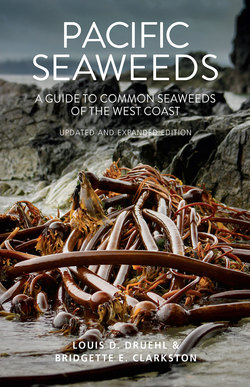Читать книгу Pacific Seaweeds - Louis Druehl - Страница 24
На сайте Литреса книга снята с продажи.
ОглавлениеPacific Seaweeds
24
Seaweed Names
Every known species has a scientific name, and some species also have a common name. For example, Nereocystis luetkeana is the scientific name for the species commonly known as “bull kelp.” The common name is the name by which a species becomes known among lay people and can be very useful, especially in cases where the common names are universally applied, such as with breeds of dogs and species of birds. However, in most cases a common name may refer to any of several species and is often haphazardly applied or region specific. For example, ask someone from the Pacific Northwest to show you “bull kelp” and they point to Nereocystis luetkeana; ask the same of someone from Australia, New Zealand or South Africa and they point to Durvillaea antarctica, a different species altogether. On top of that, a single species may have more than one common name: Nereocystis luetkeana is also (though much less frequently) known as “bladder kelp” or the delightfully imaginative “sea otter’s cabbage.”
In contrast, the critically important feature of scientific names is their lack of ambiguity: Nereocystis luetkeana applies to only one species, allowing confident communication about this species by scientists and professionals no matter where they are in the world—this is the power and beauty of scientific names.
The two parts to the name are informative. The first part is the “generic” or “genus” name and is applied to multiple species when they are closely related—e.g., the lion (Panthera leo) and tiger (Panthera tigris).The second part (e.g., leo) is the “specific” or “species” name and tells you that you’re talking about a lion and not a tiger. Both a genus and a species are required in a scientific name. These names are usually derived from Latin or Greek—which can make them tongue-twisters—and may or may not describe some feature of the species: e.g., the name of the five-rib kelp, Costaria, comes from the Latin costa (a rib), but the sea palm kelp, Postelsia, is named for the Estonian naturalist Postels.
The majority of our seaweeds do not have widely accepted common names. In this guide we include only those common names that we consider to be well established. Our advice is to use the scientific name and attach a descriptive phrase if you find this helpful; for example: Costaria costata, the five-ribbed kelp.
Species of seaweed are classified in a taxonomic hierarchy that reflects their relatedness. This hierarchy is universally applied to all living things and
